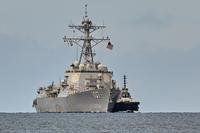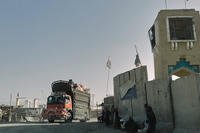The Navy says water from the aircraft carrier USS Abraham Lincoln's bilges, a type of drainage system, leaked into drinking water on the ship and was responsible for the "odor and cloudy appearance" that sailors reported last month.
That disclosure, however, raises the possibility that there were other potentially harmful substances often found in bilgewater being consumed by sailors but not previously acknowledged by the Navy.
In a statement released Friday, the Navy explained that, following an Oct. 20 inspection, the service "concluded that bilge water entered one of the potable water tanks through a hole that was found in the tank's air vent line." The service attributed the reports from sailors about foul-smelling, discolored water to that hole.
Read Next: Commander Bans Army-Issued Warm, Comfy Fleece Jacket as Winter Approaches
Issues with the drinking water were first reported by the crew on Sept. 21. Several videos of the water aboard the carrier were posted by sailors to social media sites, showing water bottles with cloudy liquid and brown or gray particles floating inside. In one video, a sailor says: "Look at the film on top."
On Oct. 13, the Navy confirmed that E. coli contamination had been found in three of the ship's 26 potable water tanks but said that the bacteria couldn't have caused the color and odor reported by sailors. Friday's announcement from the Navy about the source of the leaks adds the specter of additional contamination problems.
A ship's bilge is generally seen as a place where spills and wastewater collect from the ship's machinery and power plants. A 1999 EPA report describes the liquid that collects in the system as "bilgewater" or "oily wastewater" and goes on to say that, while the composition of that waste "varies from vessel to vessel," it can contain "small quantities" of "fuels, lubricants, hydraulic fluid, antifreeze, solvents, and cleaning chemicals." Finding all of those chemicals in bilgewater is fairly normal, and Navy ships even have a system aboard to collect this wastewater and separate out oils before dumping it overboard.
That EPA report contains bilgewater data collected aboard the USS Theodore Roosevelt -- a carrier in the same class of ship as the Lincoln -- that shows its bilgewater not only contained oil and grease but also metals that can be toxic, such as cadmium, lead, arsenic and barium.
The EPA researchers found that these same compounds and elements were present in the bilgewater of 10 different Navy ships that the agency studied, underscoring the ubiquity of potential contaminants in the systems across the fleet.
On Sept. 24, the ship sent samples of its water to be tested by Orange Coast Analytical, a private lab.
The Navy said that the "results came back on Sept. 26 indicating that the water was within drinking water standards for pH, turbidity, aluminum, copper, lead, sodium, and hardness."
Military.com has asked the Navy to further explain what tests the ship's drinking water was subjected to but did not receive an answer prior to publication.
A Navy medicine publication on water quality aboard ships notes that the crew is responsible for testing the pH and salt content of the water, as well as making sure it is free of E. coli and similar bacteria. The document makes no mention of testing for any of the compounds, including toxic heavy metals the EPA report notes are frequently present in bilge water
The Navy previously said that the crew's response to track the issue to the three contaminated tanks and isolate them from the system meant that by Sept. 22, the day after the initial reports of issues, the water cleared up. The crew was initially told E. coli was the culprit by their commander, Capt. Amy Bauernschmidt, according to some of the videos sailors posted to social media.
In one video, Bauernschmidt is heard informing her crew about the positive E. coli results before adding that "before anybody starts freaking out ... E. coli is an extremely common bacteria." Sailors' protests quickly drown out her voice in the video with shouts like, "That's not how that works!"
A Navy official confirmed the authenticity of the videos when previously asked about them by Military.com.
The growing questions about whether the drinking water aboard the Lincoln was safe echo those surrounding issues another carrier in the fleet, the USS Nimitz, was having with jet fuel in its water. News of that contamination also became public after sailors made allegations and posted images to social media. The Navy was quick to declare the matter resolved but had to reverse course over the ensuing days as the contamination persisted and reports of illnesses trickled in.
In three of the four videos of Bauernschmidt's announcements to the crew posted online, she is heard telling her crew that there is no jet fuel in their water.
-- Konstantin Toropin can be reached at konstantin.toropin@military.com. Follow him on Twitter @ktoropin.
Related: Is There Sewage in This Carrier's Water? The Navy Doesn't Know













